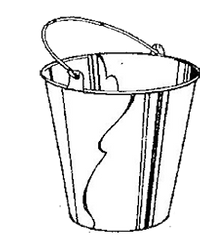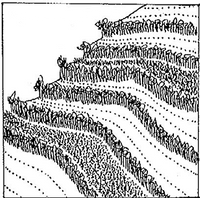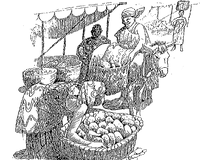- Introduction
- Principal Problems of Agriculture in Arid Regions
- Agricultural Techniques for Arid Lands
- Crop Plants for Tropical Arid Regions
- Animals for Dry Regions of the Tropics
- Useful Publications and Additional Resources (prepared by ECHO staff)
In every region of the world it is necessary to find or develop appropriate techniques for agriculture. A large part of the surface of the world is arid, characterized as too dry for conventional rain fed agriculture. Yet, millions of people live in such regions, and if current trends in population increase continue, there will soon be millions more. These people must eat, and the wisest course for them is to produce their own food. Yet, the techniques are so varied that only a very large volume would cover the entire subject. This publication is only a primer, an introduction to appropriate techniques. More extensive treatments are mentioned in the bibliography. In many cases the most suitable techniques for a particular region may be those already developed by the local inhabitants. In some cases it will be difficult to improve on local techniques, but at times even simple and inexpensive innovations may be almost revolutionary. This bulletin suggests that one must begin to improve local agriculture in arid zones by learning what is already there. Then both techniques and plants that may be useful in specific situations are suggested.
Definitions and degrees of aridity. "Arid" implies prolonged dryness, and is used with respect to the climate and the land below it. In such regions the ability to produce agricultural crops is restricted. Usually on arid lands the potential evaporation of water from the land exceeds the rainfall. The land may be characterized according to the degree of aridity as dry forest, chaparral or brushland, grassland or savannah, or desert. "Arid" does not adequately characterize the soils, however, for they may vary in many ways. Often they are alkaline or saline.
Several degrees of dryness must be recognized. The first is where the dry climate is modified by seasonal rainy seasons. In such a region it might be possible to produce a wide range of annual crops during the short rainy season, enough to sustain animals and feed mankind, although few food or feed trees might be feasible without special techniques. The second situation is a year round aridity, sometimes modified by light or irregular rains, which might make production of crops impossible. The third situation is where water is brought in by wells, canals, or other means so that normal agriculture can exist, in spite of the aridity of the climate. This primer concerns the first two situations, but not the third. There are techniques suitable for all arid regions.
Principal arid regions of the world. Arid regions are often extensive, but in the tropics it is common, even on a small island, to find arid regions near regions of abundant rainfall. The large arid regions are:
North America Africa
Much of Western USA The Sahara Desert
The Sonoran Desert The Sahel
The Kalahari Desert
Central America East Africa
The Pacific Coast
South America Asia
The Atacama Desert The Middle East
The Serrano of Brazil The Indian or Thar Desert
The Namub Desert
Australia The Karakum Desert
The Central Deserts The Gobi Desert
However, while the above mentioned regions may constitute the most arid regions, nevertheless, there are many more areas, large and small, where aridity is a problem.
PRINCIPAL PROBLEMS OF AGRICULTURE IN ARID REGIONS
Water. Water is absolutely necessary for all plant and animal life. Plants have evolved that are capable of living and reproducing in semi-arid, arid, and even desert regions. However, as aridity increases, fewer and fewer species are adapted, and the potential biomass is reduced.
 Plants are adapted to aridity by several mechanisms. There are plants with a short life cycle that can germinate, grow, and produce during a very short period of available moisture. There are plants with deep or extensive root systems which have the ability to gather water over a wide area. There are plants which store up water in their tissues and release it very slowly. There are plants that are protected from water loss by wax or other impediments. There are plants with very small or narrow leaves, thus reducing water loss. There are plants in which the tissues themselves can withstand muchdesiccation without dying. Crop plants in arid regions may have any or a combination of such mechanisms.
Plants are adapted to aridity by several mechanisms. There are plants with a short life cycle that can germinate, grow, and produce during a very short period of available moisture. There are plants with deep or extensive root systems which have the ability to gather water over a wide area. There are plants which store up water in their tissues and release it very slowly. There are plants that are protected from water loss by wax or other impediments. There are plants with very small or narrow leaves, thus reducing water loss. There are plants in which the tissues themselves can withstand muchdesiccation without dying. Crop plants in arid regions may have any or a combination of such mechanisms.
Water that falls in arid regions may be of little use for crop plants because the amount is too small to penetrate the soil sufficiently, or it may run through a porous soil too quickly, or it may run off too quickly. Furthermore, weedy species may be so adept at utilizing scarce water that they rob the water from crops. On the other hand, some soils store water so efficiently that it is possible to grow crops over an extensive period of drought.
Water from rivers, lakes and wells in arid regions may have problems of quality, especially the presence of excess minerals. The use of irrigation water might lead to the accumulation of salts in the soil resulting in alkalinity or salinity, which might then limit crop production. The removal of salt from the soil is very difficult.
In all arid regions a major challenge is to manage water appropriately. The purpose of such management is to obtain water, to conserve it, to use it efficiently, and to avoid damage to the soil.
Heat and Wind. The major effects of heat and wind are to increase the rate of evaporation, and thus to increase the effects of aridity. Wind may also cause mechanical damage to crops. Both are combatted by changing the microclimate. The effects of winds can be reduced by windbreaks (lines of trees perpendicular to the direction of prevailing winds). Some useful tall species are tamarisk, casuarina, and eucalyptus. A windbreak can consist of trees and other plants of varying height. As a general rule, a windbreak is effective over an area 2.5 times the height of the tree. One must remember, however, that a windbreak may also rob crops of light, water and nutrients. Thus, the advantages of a windbreak must be weighed against the disadvantages in any particular environment. Windbreaks can also be constructed of non-living materials, which are likely to be expensive.
Heat is received principally from the sun and can be reduced by shading. But, shading also reduces the yields of plants. A  light shade such as that below a coconut planting or a protective screen or lathwork can be useful in reducing heat and retaining moisture, with only a minimum loss of yield.
light shade such as that below a coconut planting or a protective screen or lathwork can be useful in reducing heat and retaining moisture, with only a minimum loss of yield.
Soils. Soils of the arid tropics are highly variable, as they are in any climate. Nevertheless, it is possible to make some generalizations about such soils. Because of the low rainfall and consequently reduced plant growth, organic material is produced slowly. Yet, again because of low rainfall, it may be broken down slowly as well. The amount of organic material in the soil, and thus the potential fertility, is likely to be high in semi-arid zones, low in deserts.
Because of low rainfall in desert soils, minerals derived from breakdown of rocks are not leached from the soil. In some cases where the soil is periodically flooded or irrigated the soil might be saline as well. Such soils support few crops. Soils of the semi-arid and arid zones might support few plants on the surface, but a good part of the biomass might be in the soil itself as roots. Shrubby desert plants often have very hard woody roots that may be a physical barrier to agriculture.
Disease and Pest Problems. Arid regions have their fair share of disease and pest problems. However, these may often be quite different from those of wetter regions. Nematodes are often a severe problem in sandy soils. No general rules are useful, and indeed, agriculture anticipates diseases and pests, and their parasites as well.
AGRICULTURAL TECHNIQUES FOR ARID LANDS
Many of the techniques for agriculture in arid lands are not very different from those in other climatic zones. The unique problems of arid lands are almost entirely related to water or its effects over long or short times. Therefore, the discussion here revolves around two questions: "How to capture existing water," and "How to use water wisely."
How to Capture Existing Water
Much of the water that falls on arid lands is lost by runoff, deep penetration into sands, or by evaporation. Runoff can be captured for later use in natural or nature-like ways, or in manmade structures. These include the following:
1. Furrows, and diking of furrows, ditches, and pits following contours to slow the runoff of water and permit deeper penetration.
2. Similar structures reinforced by bench terraces, vegetative strips, or trees for alley cropping.
3. Crescent-shaped basins arranged to gather water for one or more trees.
4. Reservoirs of water, such as natural or constructed shallow basins along roads which capture runoff, earth structures that lead water into aquifers (underground streams), rock or clay-lined underground basins.
5. Other man-made structures. These include cisterns (household or community sized clay, stone, or concrete tanks, check dams (small structures that impede water movement in a stream), and conventional dams.
How to Obtain New Water
 In many arid regions water can be obtained from wells. The depth of the well necessary to obtain water may vary a few to thousands of feet. Water in wells is either fossil (stored over impermeable layers for thousands of years), or from water that has entered the soil from rain, and is therefore stored rainwater. Both sources of water are limited and can be exhausted.
In many arid regions water can be obtained from wells. The depth of the well necessary to obtain water may vary a few to thousands of feet. Water in wells is either fossil (stored over impermeable layers for thousands of years), or from water that has entered the soil from rain, and is therefore stored rainwater. Both sources of water are limited and can be exhausted.
New water is also obtained by condensation from the air, either onto metal screens or plastic (the principle of the solar still) or onto foliage. Ingenious systems can be developed to capture this condensation. This source of water depends on nighttime temperatures that lower to the point of condensation.
How to Conserve Existing Water
Water that is conserved is just as valuable as water that is obtained, and conservation is one of the best strategies for arid zones. There are many techniques, here presented only as lists.
At the level of the home: Reduce water use in the home. Capture gray water (from kitchen and bath) for later use in the garden. Use overflow from septic tanks to irrigate trees.
On the farm or garden: Reduce evaporation with windbreaks and light shade. Plant in the best soil, and lead runoff water to it. Plant in furrows, pits, or swales. Establish plants in a nursery in pots, when feasible, for later transplanting. Keep the soil rich in organic material. Use drought resistant crops or varieties, when possible. Maximize use of trees that produce food in arid regions. Plant during appropriate seasons. Use mulch, but not in excess. Irrigate efficiently (usually the most efficient system is drip irrigation). Keep weeds down. Eliminate crop plants as soon as they finish producing.
Other techniques
Hillside farming. The special aspect of hillside farming that merits attention here is that water rapidly runs off and often causes erosion. Thus, hillsides can be arid even in an otherwise wetter climate. The techniques required for successful hillside farming are those that capture water, minimize runoff and erosion, and help build soil fertility. Some techniques are very simple, such as plowing along the contour and leaving vegetative strips between planting. Some are more complex and expensive, and may require engineering, such as building bench terraces, correcting gullies, and building ponds and dams.
The most elegant techniques and probably the most satisfactory are associated with the use of multiple purpose legumes in systems of alley cropping. Trees along the contours are used to gradually develop terraces and meanwhile enrich soil by capturing nitrogen and bringing up deeply buried nutrients, making them available in foliage, used as fertilizer. In addition, such trees may furnish firewood, feed, or occasionally food.
The crops for hillsides should be those with very deep roots or that can take advantage of short times of availability of water.
Use of trees. Trees will often be the most useful crop plants in arid regions, for with deep roots they can make maximum use of water. Trees will need special protection when they are planted, including irrigation in time of need. A good tree crop ought to fill many purposes.
of water. Trees will need special protection when they are planted, including irrigation in time of need. A good tree crop ought to fill many purposes.
Residual moisture. In some soils in arid regions with short rainy seasons, crops are planted near the end of the rainy season and even after rains have ceased in order to take advantage of moisture stored in the soil. Tepary beans are produced using this principle. Melons are often used as such crops in Central America.
Alternate years. A common practice in arid regions is to plant only every other year. During the year when the ground is left fallow, weeds, which use up the water in the soil, are controlled. This type of planting is suitable only for soils with a large capacity to store water. This will be evident when the crops or weeds on a soil remain green for a long period after rains have ceased.
Feeding of animals. Crop residues, both harvested and those left in the fields, may be used as feed during dry seasons. Animals such as cattle, goats, sheep, hogs, chickens, and ducks clean up the field and can help eliminate weed seeds, and, of course, they also leave their manure.
CROP PLANTS FOR TROPICAL ARID REGIONS
Crop plants for arid regions are those that survive and produce in spite of aridity. However, in almost all of these crops, seeds must be germinated or cuttings must be rooted under conditions of almost normal water availability. Therefore, when one speaks of tolerance of dry conditions one is talking mostly about the drought tolerance of the growing or mature plant. In the following tables, plants that are useful in arid regions are considered. These plants vary in ability to tolerate aridity and in yields under arid conditions. Choosing the right crops for arid regions might involve considerable experimentation in a particular region, and, in fact, the development of suitable production systems might require years. This should come as no surprise. Native systems, as crude as they may appear, usually represent the accumulated wisdom of centuries of experimentation. If this is so, how can one hope to make an improvement? The answer is often in the introduction of species or varieties unknown in the region. In other cases it is the introduction of technologies developed in other regions (see Useful Publications and Additional Resources).
TABLE 1. FOOD PLANTS FOR DRY REGIONS OF THE TROPICS
-----------------------------|---------------------|-------------------------
Scientific name | Common name | Degree of Tolerance
| | (0=none to 3=high)
-----------------------------|---------------------|-------------------------
CEREAL GRAINS: | |
Zea mays | Corn | 1
Sorghum bicolor | Sorghum | 1.5
Pennisetum americanum | Pearl Millet | 2.5
| |
GRAIN LEGUMES: | |
Phaseolus vulgaris | Common Bean | 1
Vigna unguiculata | Cowpea | 1.5
Cajanus cajan | Pigeon Pea | 2
Dolichos lablab | Lablab Bean | 2
Vigna radiata | Mung Bean | 2
Phaseolus acutifolius | Tepary Bean | 2.5
Vigna aconitifolia | Mat Bean | 2.5
Tylosema esculentum | Marama Bean | 3
| |
LEAFY VEGETABLES: | |
Symphytum officinale | Comfrey | 1
Manihot esculenta | Cassava | 1
Cnidoscolus chayamansa | Chaya | 2
Moringa oleifera | Moringa | 2
Leucaena leucocephala | Leucaena | 2.5
| |
ROOT CROPS: | |
Dioscorea rotundata | White Yam | 1
Manihot esculenta | Cassava | 2
Sphenostylis stenocarpa | African Yam Bean | 2
| |
VEGETABLES: | |
Citrullus lanatus | Watermelon | 1
Cucurbita mixta | Mixta Squash | 1.5
Cynara scolymus | Globe Artichoke | 1
Abelmoschus esculentus | Okra | 1.5
| |
FRUIT TREES: | |
Carica papaya | Papaya | 1
Pouteria campechiana | Canistel | 1
Psidium guajava | Guava | 1
Spondias cytherea | Golden Apple | 1
Olea europaea | Olive | 1.5
Tamarindus indica | Tamarind | 1.5
Zizyphus jujuba | Jujube | 1.5
Carissa carandus | Karanda | 2
Dovyalis abyssinica | Dove Plum | 2
Punica granatum | Pomegranate | 2
Anacardium occidentale | Cashew | 2.5
Opuntia spp. | Prickly Pear Cactus | 2.5
Phoenix dactylifera | Date | 3
| |
OIL PLANTS: | |
Pentaclethra macrophylla | Owala Oil | 1
Helianthus annuus | Sunflower | 1
Butyrospermum paradoxum | Shea Butter | 2
| |
MISCELLANEOUS: | |
Catha edulis | Khat | 2
-----------------------------|---------------------|-------------------------
 TABLE 2. NON-FOOD PLANTS FOR ARID REGIONS
TABLE 2. NON-FOOD PLANTS FOR ARID REGIONS
-----------------------------|---------------------|-------------------------
Scientific name | Common name | Degree of Tolerance
| | (0=none to 3=high)
-----------------------------|---------------------|-------------------------
FEED LEGUMES: | |
Gliricidia sepium | Mother of Cacao | 1.5
Ceratonia siliqua | St. John's Bread | 1.5
Prosopis spp. | Mesquite | 2
Leucaena leucocephala | Leucaena | 2.5
Acacia albida | Apple Ring Acacia | 2.5
Acacia tortilis | Umbrella thorn | 2.5
Parkinsonia aculeata | Jerusalem Thorn | 3
| |
FEED GRASSES: | |
Cynodon dactylon | Bermuda Grass | 1
Digitaria decumbens | Pangola Grass | 1
Sorghum sudanense | Sudan | 1
| |
FIBER PLANTS: | |
Gossypium barbadense | Sea Island Cotton | 1
Agave fourcroydes | Henequen | 2
Agave sisalana | Sisal | 2.5
| |
TIMBER PLANTS: | |
Swietenia mahogoni | Mahogany | 1
Acacia tortilis | Umbrella Thorn | 2.5
| |
PLANTS FOR ALLEY CROPPING: | |
Gliricidia sepium | Mother of Cacao | 1.5
Cajanus cajan | Pigeon Pea | 2
Leucaena leucocephala | Leucaena | 2.5
| |
GROUND COVER: | |
Dolichos lablab | Lablab Bean | 2
Canavalia ensiformis | Jack Bean | 1.5
| |
WINDBREAK: | |
Casuarina spp. | Casuarina | 2
Eucalyptus spp. | Eucalyptus | 1.5
Tamarisk spp. | Tamarisk | 2.5
| |
LIVING FENCE: | |
Gliricidia sepium | Mother of Cacao | 1.5
Bursera simaruba | Gumbo Limbo | 1.5
Acacia nilotica | Babul Acacia | 2.5
Euphorbia tirucali | Pencil Euphorbia | 3
-----------------------------|---------------------|-------------------------
ANIMALS FOR DRY REGIONS OF THE TROPICS
Why Animals?
In dry regions of the tropics where agriculture is always difficult, animals are frequently more capable of utilizing the often  abundant plants that are available, and many times can be fed with crop residues. While some feed crops are given in Table 2, the most important feeds in many regions will be those which grow by themselves, naturally and untended. Sometimes improvement of this natural fodder by fertilizing, watering, or selected weeding may be the best solution to increasing the yield of animal feed. In addition, appropriate care of animals is necessary, and even poor herdsmen are often very skilled in raising animals.
abundant plants that are available, and many times can be fed with crop residues. While some feed crops are given in Table 2, the most important feeds in many regions will be those which grow by themselves, naturally and untended. Sometimes improvement of this natural fodder by fertilizing, watering, or selected weeding may be the best solution to increasing the yield of animal feed. In addition, appropriate care of animals is necessary, and even poor herdsmen are often very skilled in raising animals.
Animals on the farm can be used for a wide variety of purposes. In addition to excellent food in the form of eggs, milk and meat, animals serve as beasts of burden, and can be trained to handle difficult jobs on the farm. The dung is a useful resource for crop production but is also used in plastering walls and floors, and when dry, as fuel. Animal wool, hair, or fur can be used in bedding and clothing.
Principal Animals and Their Characteristics
Cattle. In many arid regions the production of cattle might be the best way to make use of land. Cattle feed principally on grasses, but also benefit from legumes. They are much less apt to graze or browse on shrubs than goats. They are very adept at finding something useful to eat on grasslands, even during the dry season. Cattle may be used for milk, for meat, for farm labor, and for their hides and other by-products. There are many breeds of cattle, often used for a single purpose, or at times serving for two or more main purposes, and some of these will be much more adapted to a given situation than others. Choosing the appropriate breed or strain of cattle will always be important.
The carrying capacity of land, the number of cattle (or, other animals that can be raised on it), will vary widely, and can determine the success or failure of a given venture. Cattle may graze in open range or fenced pastures, but in either case, rotation is necessary in order to not destroy the future potential of the grazing area. Improvement of the grazing area can be achieved by the introduction of new grasses or legumes, by fertilization, occasionally by fire (a risky process), by killing poisonous plants, and by eliminating brush and some trees. Some breeds will gain more on a given pasture than others.
Since cattle raising is a capital-intensive effort (even the cattle represent considerable capital), a great deal of investigation and local knowledge is desirable before embarking on such an enterprise. On the other hand, raising the family cow is possible almost everywhere and can be the foundation of success on the small farm.
Goats. Goats may be produced for about the same purposes as cattle, and their smaller size makes them suitable for many situations. They are often grazed on open range in arid regions. They are browsers (nibble at a variety of plants), and sometimes are better adapted to production of useful meat than cattle, especially in heavy shrubland. While goats may be raised for milk, the really fine milk varieties are not well adapted in the tropics.
Sheep. In addition to the wool-bearing sheep of the temperate zone, there exist hair sheep which are much better adapted to the tropics. In addition to their value in producing meat, such sheep are often used to control weeds in orchards, and thus constitute a profit-producing biological control.
Burros. The small donkey of the drylands of the world is supremely adapted to living off the browse and meager feed often available, and for its size is surprisingly strong and a magnificent beast of burden. Not to be laughed at, the burro can easily be adapted to useful roles on the farm, including basic transportation and pulling carts.
Camels. This species is best adapted to very dry areas where agriculture is very limited.
The choice of animals for the farm in the arid tropics, and the techniques used to raise such animals are very important, and vary considerably from one region to another.
Feed Crops
After adaptation, no element in the production of animals is more important than feed. Farmers may be quite conscious of acceptable treatments in care and breeding of their animals. They may not be aware of the progress that could be made by improvement of feeds, even though such advice may be available through local agricultural experiment stations, extension services, or the department of agriculture. A first step in improving animal production should be to learn how farmers are feeding animals, and the second step is to learn what feeding practices are recommended. A third possible step, much more difficult, is to learn the feeding practices in areas of similar soils and climates.
 A major problem in the production of animals is what to feed them during the dry season. An efficient production system includes solving this problem in advance. Some of the potential solutions include: dry season irrigation of pastures; restricted grazing of pastures during wet seasons so that feed will remain for the dry season; harvest and storage of wet feed as silage; harvest and storage of dry feed as hay, or as seed, in the case of grain crops; cultivation of feed crops adapted to arid zones; and migration to more productive areas.
A major problem in the production of animals is what to feed them during the dry season. An efficient production system includes solving this problem in advance. Some of the potential solutions include: dry season irrigation of pastures; restricted grazing of pastures during wet seasons so that feed will remain for the dry season; harvest and storage of wet feed as silage; harvest and storage of dry feed as hay, or as seed, in the case of grain crops; cultivation of feed crops adapted to arid zones; and migration to more productive areas.
One of the most useful possibilities for increasing dry season feed is the use of crop residues. The value of such residues as feed varies, and sometimes other substances are added to enhance palatability or nutritive value. In a well-managed agricultural enterprise of any kind, it will be useful to look for such potential uses of residues.
Another solution to the problem of dry season feed shortage is to reduce the size of the herd as the dry season approaches. The frequent practice of letting animals go hungry cannot be recommended as good husbandry.
USEFUL PUBLICATIONS AND ADDITIONAL RESOURCES
(prepared by ECHO staff)
Agroforestry Technology Information Kit by The International Institute of Rural Reconstruction (475 Riverside Drive, Room 1035, New York, NY 10115, USA) cost: $27. Kits are also available as well from their headquarters in the Philippines: IIRR, Silang, Cavite 4118, PHILIPPINES.
Agroforestry in Dryland Africa by Rockeleau, D., Weber, F. and Field-Juma, A. 1988, ICRAF (International Centre for Research in Agroforestry, P.O. Box 30677, Nairobi, KENYA). 311 pp. cost: $31.00.
Crops of the Drier Regions of the Tropics by D. Gibbon and A. Pain, available from Longman Scientific & Technical, Longman Group UK Ltd., Longman House, Burnt Mill, Harlow, Essex CM20 2JE, UK.
ECHO's Technical Note on Dry Farming by Randy Creswell, cost $3.00.
Haloph: A Data Base of Salt-Tolerant Plants of the World by James A. Aronson, 1989, Office of Arid Lands Studies (The University of Arizona, 845 North Park Ave., Tucson, AZ 85719, USA).
Lost Crops of Africa, Volume 1: Grains (NAS), limited supply available from ECHO.
More Water for Arid Lands: Promising Technologies and Research Opportunities and Saline Agriculture: Salt-Tolerant Plants for Developing Countries, both by National Academy of Science (National Research Council, Office of International Affairs, 2101 Constitution Avenue, Washington, D.C. 20418, USA). Order from AgAccess, P.O. Box 2008, Davis, CA 95617, USA; phone 916/756-7177.
The Challenge of the Negev by Dr. Evenari (Ben-Gurion University of the Negev, P.O. Box 1025, Beer-Sheva 84110 ISRAEL).
Food from Dryland Gardens by David A. Cleveland and Daniela Soleri (Center for People, Food and Environment, 344 South Third Ave., Tucson, AZ 85701, USA). A comprehensive handbook.
Practical Guide to Dryland Farming Series: Introduction to Soil and Water Conservation Practices; Contour Farming with Living Barriers; Integrated Farm Management; and Planting Tree Crops by World Neighbors in Indonesia (Studio Driya Media; Jl. Tubagus Ismail Raya No. 15; Bandung, West Java 40143; Indonesia) available at $4 per booklet from World Neighbors, 4127 NW 122 St., Oklahoma City, OK 73120-8869, USA; phone 405/752-9700.
Seed Sources for Arid Land Gardeners
See the chapter on Seeds and Germplasm.
Information Sources for Arid Land Gardeners
Office of Arid Land Studies (The University of Arizona, 845 North Park Ave., Tucson, AZ 85719, USA).
The Center for People, Food and Environment (344 South Third Ave., Tucson, AZ 85701, USA).
Maricopa Agricultural Center (37860 W. Smith-Enke Rd., Maricopa, AZ 85239, USA).
Int'l Crops Research Institute for the Semi-Arid Tropics (Patancheru, P.O. Andhra Pradesh 502-324, INDIA).
International Center for Agricultural Research in the Dry Areas (P.O. Box 5466, Aleppo, SYRIA).
Drought Defenders Project (Henry Doubleday Research Assn., Ryton-on-Dunsmore, Coventry, CV8 3LG, UK).
Arid Lands Information Network (174 Banbury Road, Oxford, OX2 7DZ, UK). Publish "Baobab," a networking publication for those working in arid lands.
International Institute for Environment and Development (3 Endsleigh St., London, WC1H ODD, UK; phone +44 71-388-2117; fax +44 71-388-2826; e-mail iieddrylands@gn.apc.org). Publish the quarterly "HARAMATA, Bulletin of the Drylands."
SEPASAL (Survey of Economic Plants for Arid and Semiarid Lands, Centre for Economic Botany, Royal Botanic Gardens, Kew, Richmond, Surrey TW9 3AE, UK; fax +44 81-332-5278). Plant information database.
Video
Looking After our Land: Soil and Water Conservation in Dryland Africa. (Oxfam Publications, c/o BEBC, P.O. Box 1496, Parkstone, Poole, Dorset BH12 3YD, UK; phone 01202 715555; fax 01202 715556.) A two-hour tape (œ14.95) and an illustrated 88-page book (œ8.95); specify whether you want the English or French version and whether your video equipment uses the PAL, SECAM or NTSC system.